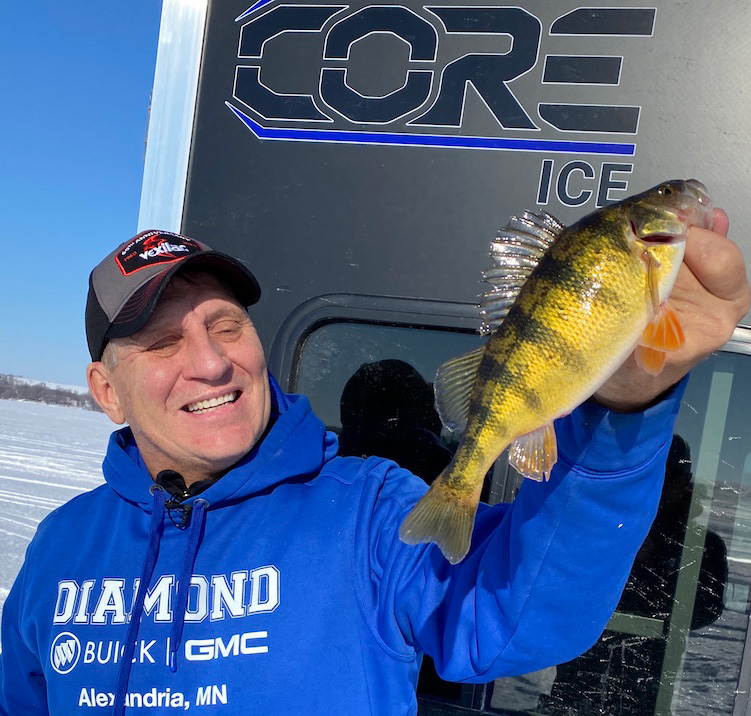On the Move for a Better Winter Bite!

On the move for a better winter bite!
By Mike Frisch
Recently I traveled to Big Stone Lake to fish with winter fishing guide Tanner Arndt. Tanner and his dad, Artie, also own and run Artie’s Fish House Rentals on Big Stone. The Arndt’s specialize in, and pride themselves on, putting their customers on lots of Big Stone’s numerous and delicious perch. Suffice to say, Tanner spends lots of time on the ice.
Whenever I’m considering a trip to Big Stone, I call Tanner for the latest fishing report and sometime during that conversation I usually here something like, “if you stay after ‘em, you’ll find some.” In other words, I need to be prepared to drill holes and stay on the move looking for feeding fish. Big Stone is 26-miles long and lots of the lake is a featureless basin that the perch roam during winter searching for food. This is classic “here today, gone tomorrow” fishing.
Run and gun fishing is usually productive on Big Stone, but certainly not unique to ice fishing or to this particular lake. In fact, regardless the lake, often the most successful ice anglers are those who are willing to stay on the move. This seems to become especially important during mid-winter when the activity levels of fish often diminish and, the best spots often become much less productive as the result of intense fishing pressure.
Staying active searching for fish requires effort, but it’s effort that can also yield great reward. A few winters back a couple partners and I spent the better part of a day drilling holes and moving spot to spot searching for big bluegills. Finally, we found a remnant weedline with some still green weeds that was loaded with 9-inch plus bluegills. This spot was productive that day and on several subsequent trips until word got out and fishing pressure increased. Then it was time to get back to search mode!
A couple things are important to being an efficient and effective winter fish searcher. First, good sonar like a Vexilar flasher is always important. Sonar allows an angler to see bottom, the bait being fished, and any fish around it. Sonar is also helpful in identifying weeds and other types of potential fish-holding cover. I only fish a hole for a few minutes when searching before moving on to the next if fish or good cover aren’t “seen” on my sonar.
In addition to sonar, a reliable, fast-cutting ice auger is also paramount to this approach. The K-Drill auger I use runs off a cordless electric drill so it’s a reliable starter and it’s super lightweight when drilling lots of holes and moving spot to spot.
Sonar and a good auger are important when I’m in search mode, but what about shelter from the elements? Some anglers prefer fishing outside or from portable shelters, but I’ve found recent success, and more comfort, using a CORE ICE hard-sided shelter featuring the innovative hybrid wheel/skid system.
This house can be towed to the lake behind a truck with the “on ice” tow vehicle (like an ATV) stored in the shelter and then unloaded at the lake and hooked to the shelter. Employing the skid system, the house can then be towed from spot to spot with no more set up other than drilling holes at new fishing spots. This system allows for great portability, yet heated comfort as well. And, it has proven especially effective with some of the treacherous ice conditions seen on lots of lakes in recent winters.
If finding more active fish this winter is your goal, then consider staying active and searching new spots for “fresh” fish and the best bite. Utilizing some of the tips just presented can help in that process and hopefully put more fish in your pail this winter!
Mike Frisch is co-host of Fishing of the Midwest TV. View the website: www.fishingthemidwest.com to see more from Fishing the Midwest, including how to enter to win a Vexilar winter sonar unit!
Photo – Mike Frisch with a Big Stone perch caught on a recent trip there.

